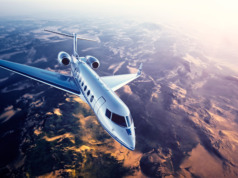With much of the business aviation community gathered at the annual NBAA-BACE 2018 convention in Orlando, FL in mid-October, one of the hottest topics of discussion and debate on the floor of the Orange County Convention Center was the state and direction of the bizav marketplace.
After a long, slow recovery period that has now outlasted most business cycles, we can say beyond a doubt that most signals we monitor are pointing in a positive direction.
Pre-owned business aircraft sales, coming off of a torrid pace in 2017, have only now begun to peak, throttled back more by a lack of attractive, young inventory rather than attractive, young customers. Business aircraft manufacturers are reporting stronger order intakes, and – perhaps just as importantly – firmer pricing, as one of the last holdout indicators of industry health in the post-2008 financial crisis begins to turn green again.
We are only just now beginning to witness the results of years of R&D investments by airframers, their engine and avionics partners, and countless others across the global supply chain, as new business aircraft are certified and enter into service. It’s a far cry from the doldrums of the 1980s, when year-over-year aircraft sales were stubbornly flat and cutbacks in employment, investments, and production lines throughout the business aircraft industry were the name of the game. Today we see that there are enticing new designs and a wider variety of choices of new models to choose from than ever before.
Ironically, and after an extended period of flattish new aircraft deliveries over the past six to seven years, it can be argued that we currently have too many manufacturers building too many aircraft models for the level of demand. In many ways, business aviation customers have never had it so good. For those still waiting for the good ol’ days to return, we might suggest that the good times are already back with us.
In the best American tradition, prospective customers were encouraged to “come ’n git it” in Orlando, and through the end of what looks to be a very busy year-end for business aircraft transaction professionals. Fueled in part by still-new U.S. tax and depreciation laws that have been priming the proverbial pump all year, Q4 2018 should have the sales bells clanging as the days count down and the available inventory of pre-owned aircraft and unsold production “white tails” evaporates. OEMs with immediate availability of new aircraft for late 2018 delivery will be working into the wee hours on December 31 to bring every aircraft they can into the hands of eager customers before the midnight hour strikes.
The U.S. is home base to almost six out of ten of the world’s business jets and turboprops, a remarkable concentration in an industry that claims to be global, but by many measures isn’t yet so. Blessed with an as-of-yet unmatched mix of aviators, airports, private air terminals and maintenance shops, locally produced aircraft, mostly friendly equipment lenders and lessors, and all manner of affiliated industries, the U.S. is and will continue to be the dominant force in business aviation for years and years to come. Our latest market forecast, which looks out into the ten-year future, predicts little change in the geographic mix of the fleet over the decade. At least for the time being, the state of the business aviation market will be driven largely by the state of the States. This trend has some fascinating implications for market watchers, market participants, and market makers.
Size Matters
As has been repeatedly proven in business aircraft, as in other segments of the transportation equipment industry, size matters, and it seems to matter even more as the years go by. Ongoing research by the U.S. Centers for Disease Control and Prevention suggests that 40% of U.S. adults aged 20 years or older were overweight in 2015-2016, up a remarkable 1/3rd from 1999-2000, when that figure was 30% of the population. Among 40-59 year olds – a prime age bracket that encompasses many business aviation users – 43% of Americans were categorized as overweight, according to data from the National Health and Nutrition Examination Survey.
Combine these data with the fact that Americans are also getting taller and taller. What on Earth does this have to do with business aviation markets, you might say? Well, as it turns out, probably quite a bit.
It is hard to imagine how – or why – many would even seriously consider a business aircraft if it did not provide many (perhaps even every) comfort and convenience of the home and office to which they have become accustomed.
Whether in the form of the latest ultra-high-speed internet access, the cradling effect of a larger chair design that would relax even a Type A personality A-lister, or the turbulence-bump-softening technology of fly-by-wire controls, the latest business aircraft features offer much to separate someone from their hard-earned greenbacks. When these features are combined with wide-body, flat floor, stand-up cabins, higher speeds up to Mach 0.925, HUD and SVS systems, steep approach and short-field capability, and that all-important scent of new Italian leather, what’s not to like?
With U.S. corporations reporting record profitability – a staggering $2 trillion after tax on an annualized basis in the year ending March 2018, with higher levels expected as more profits are repatriated throughout the year – corporate buyers never have had such a storehouse of cash to invest in assets, from new buildings to new businesses to new business aircraft.
We are expecting a very strong finish to 2018 for business aircraft sales, with most of the activity concentrated in the U.S., which is blessed at this time with a strong currency, favorable tax and depreciation rules, an optimistic owner/operator community, plenty of fancy new airplane models from which to choose, and eager-to-get-it done aircraft sales professionals with pens and iPhones securely in hand. And what a ride it should be!
With 2019 and all the uncertainties of global trade tariffs, a newly elected U.S. Congress, higher U.S. inflation and interest rates, the nightmare-turned-to-reality of Brexit, the no-kidding deadlines of ADS-B Out, and (heaven forbid) slower U.S. and Euro-Area economies, we should all enjoy the remainder of the ride. As always, and as the Captain says, we recommend that you fasten your seat belts in case there is some unexpected turbulence. Hopefully just a little light chop ahead… but we advise you to keep the belts tight just in case. BAA
Rolland Vincent is President of Rolland Vincent Associates, an aviation and aerospace market research, forecasting, and strategic planning firm. His nearly 40 years of experience includes work with manufacturers, commercial operators, and international organizations.







Rollie: just read your article in the November/December 2018 issue of Business Aviation Advisor. You demonstrated again your discernment of what might seem to be disconnected factors are really customer experience drivers . . . a gradual weight gain in the population informs passengers need wider seats in the aircraft. Business jet manufacturers noticed and designed with the latest ergonomics while the airlines ignore and pack the coach cabin.
Jim Buchanan, CAM, 25-year business aviation professional and NBAA Certified Aviation Manager Governing Board member